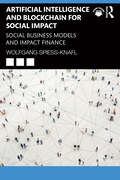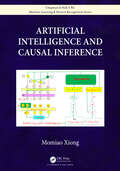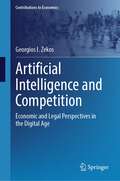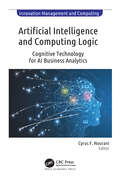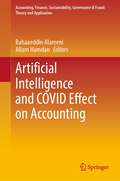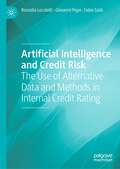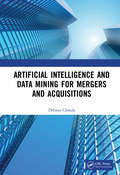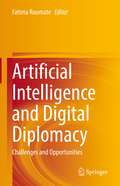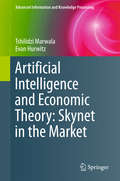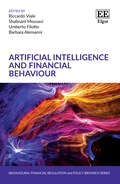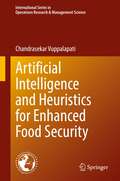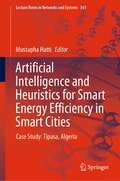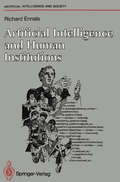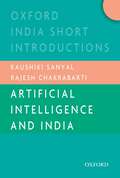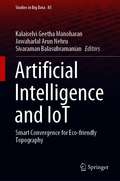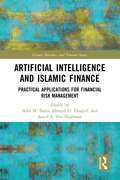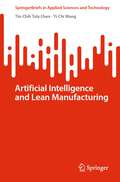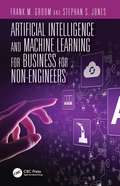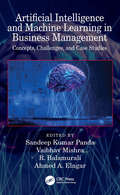- Table View
- List View
Artificial Intelligence and Blockchain for Social Impact: Social Business Models and Impact Finance
by Wolfgang Spiess-KnaflArtificial Intelligence and Blockchain for Social Impact provides an accessible overview of artificial intelligence (AI) and blockchain technologies, and explores their applications for social enterprise and impact investing. The opening chapter introduces the impact space, exploring different social business models, the role of technology, the impact investing market and general problems in the space. The remainder of this book falls into two paths: the first focusing on AI and the other looking at the blockchain technology. Providing introductions to each of these technologies and their histories, the author goes on to examine them from the perspectives of social business models and impact finance. A concluding chapter explores AI and cryptocurrencies in the impact space in the future. Readers are supported with international case studies and other student-friendly features. Situated at the intersection between technology, fintech, social enterprise, impact investing and social impact, this book is a valuable resource for upper-level courses across all these areas. It also offers an introduction to this emerging topic for researchers and business professionals. Online teaching resources to accompany this book include instructor lecture slides and data sets.
Artificial Intelligence and Causal Inference
by Momiao XiongArtificial Intelligence and Causal Inference address the recent development of relationships between artificial intelligence (AI) and causal inference. Despite significant progress in AI, a great challenge in AI development we are still facing is to understand mechanism underlying intelligence, including reasoning, planning and imagination. Understanding, transfer and generalization are major principles that give rise intelligence. One of a key component for understanding is causal inference. Causal inference includes intervention, domain shift learning, temporal structure and counterfactual thinking as major concepts to understand causation and reasoning. Unfortunately, these essential components of the causality are often overlooked by machine learning, which leads to some failure of the deep learning. AI and causal inference involve (1) using AI techniques as major tools for causal analysis and (2) applying the causal concepts and causal analysis methods to solving AI problems. The purpose of this book is to fill the gap between the AI and modern causal analysis for further facilitating the AI revolution. This book is ideal for graduate students and researchers in AI, data science, causal inference, statistics, genomics, bioinformatics and precision medicine. Key Features: Cover three types of neural networks, formulate deep learning as an optimal control problem and use Pontryagin’s Maximum Principle for network training. Deep learning for nonlinear mediation and instrumental variable causal analysis. Construction of causal networks is formulated as a continuous optimization problem. Transformer and attention are used to encode-decode graphics. RL is used to infer large causal networks. Use VAE, GAN, neural differential equations, recurrent neural network (RNN) and RL to estimate counterfactual outcomes. AI-based methods for estimation of individualized treatment effect in the presence of network interference.
Artificial Intelligence and Causal Inference
by Momiao XiongArtificial Intelligence and Causal Inference address the recent development of relationships between artificial intelligence (AI) and causal inference. Despite significant progress in AI, a great challenge in AI development we are still facing is to understand mechanism underlying intelligence, including reasoning, planning and imagination. Understanding, transfer and generalization are major principles that give rise intelligence. One of a key component for understanding is causal inference. Causal inference includes intervention, domain shift learning, temporal structure and counterfactual thinking as major concepts to understand causation and reasoning. Unfortunately, these essential components of the causality are often overlooked by machine learning, which leads to some failure of the deep learning. AI and causal inference involve (1) using AI techniques as major tools for causal analysis and (2) applying the causal concepts and causal analysis methods to solving AI problems. The purpose of this book is to fill the gap between the AI and modern causal analysis for further facilitating the AI revolution. This book is ideal for graduate students and researchers in AI, data science, causal inference, statistics, genomics, bioinformatics and precision medicine. Key Features: Cover three types of neural networks, formulate deep learning as an optimal control problem and use Pontryagin’s Maximum Principle for network training. Deep learning for nonlinear mediation and instrumental variable causal analysis. Construction of causal networks is formulated as a continuous optimization problem. Transformer and attention are used to encode-decode graphics. RL is used to infer large causal networks. Use VAE, GAN, neural differential equations, recurrent neural network (RNN) and RL to estimate counterfactual outcomes. AI-based methods for estimation of individualized treatment effect in the presence of network interference.
Artificial Intelligence and Competition: Economic and Legal Perspectives in the Digital Age (Contributions to Economics)
by Georgios I. ZekosThis book examines the impact of artificial intelligence on competition and antitrust in today's global digital economy. It scrutinizes the economic and legal ramifications of Artificial Intelligence (AI), addressing the challenges it presents to competition and the law.Beginning with an analysis of AI's developments across various economic sectors, the book highlights the need for updated legislation. It focuses on the digital economy, emphasizing digital platforms' role in shaping competition. Econometric investigations and a novel index assess competition's influence on foreign direct investment and multinational enterprises. Comparing competition practices across jurisdictions like the EU, US, Germany, and China, the book uncovers commonalities and differences in competition law principles. It also explores various theories on competition and competition law, seeking convergence or divergence.This book is an essential resource for scholars, legal professionals, policymakers, and anyone seeking a better understanding of how AI is reshaping competition and antitrust in the digital age.
Artificial Intelligence and Computing Logic: Cognitive Technology for AI Business Analytics (Innovation Management and Computing)
by Cyrus F. NouraniFocusing on the cutting-edge applications of AI cognitive computing from neuromorphic to quantum cognition as applied to AI business analytics, this new volume explores AI’s importance in managing cognitive processes along with ontological modeling concepts for venturing into new business frontiers. The volume presents a selection of significant new accomplishments in the areas of AI cognitive computing ranging from neurocognition perception and decision-making in the human brain—combining neurocognitive techniques and effective computing—to basic facial recognition computing models. Topics include: Agent neurocomputing techniques for facial expression recognition Computing haptic motion and ontology epistemic Characterizations of morph schemas for visual analytics Learning and perceptive computing Functional and structural neuroimaging modeling Observed links between facial recognition and affective emotional processes Interaction of cognitive and emotional processes during social decision-making Neurocognitive processing of emotional facial expressions in individuals Neurocognitive affective system for emotive robot androids Virtual reality-based affect adaptive neuromorphic computingExecutive surveys indicate that cognitive adoption is very important in business strategy for success and to remain competitive. Employing cognitive-based processes provides the way to get the right information in the right hands at the right time, which is the key to winning in the digital era and to driving business value that emphasizes competitive differentiation. Several chapters of the volume address the goal of using cognitive technology to improve search capabilities, to provide personalized customer service in business and in health and wellness, and to create better workflow management. Key features: Looks at the newest frontiers on very popular AI and analytics topics Discusses new techniques for visual analytics and data filtering Shows how AI and cognitive science merges with quantum neurocognitive computing Presents ontology models with ontology preservation data filtering techniques Provides a cross-transposition on AI and digitizations for business model innovationsArtificial Intelligence and Computing Logic: Cognitive Technology for AI Business Analytics is a valuable resource that informs businesses and other enterprises the value of artificial intelligence and computing logic applications.
Artificial Intelligence and Computing Logic: Cognitive Technology for AI Business Analytics (Innovation Management and Computing)
by Cyrus F. NouraniFocusing on the cutting-edge applications of AI cognitive computing from neuromorphic to quantum cognition as applied to AI business analytics, this new volume explores AI’s importance in managing cognitive processes along with ontological modeling concepts for venturing into new business frontiers. The volume presents a selection of significant new accomplishments in the areas of AI cognitive computing ranging from neurocognition perception and decision-making in the human brain—combining neurocognitive techniques and effective computing—to basic facial recognition computing models. Topics include: Agent neurocomputing techniques for facial expression recognition Computing haptic motion and ontology epistemic Characterizations of morph schemas for visual analytics Learning and perceptive computing Functional and structural neuroimaging modeling Observed links between facial recognition and affective emotional processes Interaction of cognitive and emotional processes during social decision-making Neurocognitive processing of emotional facial expressions in individuals Neurocognitive affective system for emotive robot androids Virtual reality-based affect adaptive neuromorphic computingExecutive surveys indicate that cognitive adoption is very important in business strategy for success and to remain competitive. Employing cognitive-based processes provides the way to get the right information in the right hands at the right time, which is the key to winning in the digital era and to driving business value that emphasizes competitive differentiation. Several chapters of the volume address the goal of using cognitive technology to improve search capabilities, to provide personalized customer service in business and in health and wellness, and to create better workflow management. Key features: Looks at the newest frontiers on very popular AI and analytics topics Discusses new techniques for visual analytics and data filtering Shows how AI and cognitive science merges with quantum neurocognitive computing Presents ontology models with ontology preservation data filtering techniques Provides a cross-transposition on AI and digitizations for business model innovationsArtificial Intelligence and Computing Logic: Cognitive Technology for AI Business Analytics is a valuable resource that informs businesses and other enterprises the value of artificial intelligence and computing logic applications.
Artificial Intelligence and COVID Effect on Accounting (Accounting, Finance, Sustainability, Governance & Fraud: Theory and Application)
by Bahaaeddin Alareeni Allam HamdanThis book considers the effects of COVID-19 on accounting, particularly with regard to the role of artificial intelligence in accounting in the post-pandemic business environment. The contributions in the book consider a variety of sectors that have been affected by the pandemic, such as the stock market, forensic accounting, Bitcoin, as well as the economic and educational responses to the pandemic and the aftermath felt by both developing and developed countries. This book will be a valuable read for academics, students and practitioners of accounting who are keen to explore the future of the field in light of the pandemic.
Artificial Intelligence and Credit Risk: The Use of Alternative Data and Methods in Internal Credit Rating
by Rossella Locatelli Giovanni Pepe Fabio SalisThis book focuses on the alternative techniques and data leveraged for credit risk, describing and analysing the array of methodological approaches for the usage of techniques and/or alternative data for regulatory and managerial rating models. During the last decade the increase in computational capacity, the consolidation of new methodologies to elaborate data and the availability of new information related to individuals and organizations, aided by the widespread usage of internet, set the stage for the development and application of artificial intelligence techniques in enterprises in general and financial institutions in particular. In the banking world, its application is even more relevant, thanks to the use of larger and larger data sets for credit risk modelling. The evaluation of credit risk has largely been based on client data modelling; such techniques (linear regression, logistic regression, decision trees, etc.) and data sets (financial, behavioural, sociologic, geographic, sectoral, etc.) are referred to as “traditional” and have been the de facto standards in the banking industry. The incoming challenge for credit risk managers is now to find ways to leverage the new AI toolbox on new (unconventional) data to enhance the models’ predictive power, without neglecting problems due to results’ interpretability while recognizing ethical dilemmas. Contributors are university researchers, risk managers operating in banks and other financial intermediaries and consultants. The topic is a major one for the financial industry, and this is one of the first works offering relevant case studies alongside practical problems and solutions.
Artificial Intelligence and Data Mining for Mergers and Acquisitions
by Debasis ChandaThe goal of this book is to present a modeling framework for the Virtual Organization that is focused on process composition. This framework uses Predicate Calculus Knowledge Bases. Petri Net-based modeling is also discussed. In this context, a Data Mining model is proposed, using a fuzzy mathematical approach, aiming to discover knowledge. A Knowledge-Based framework has been proposed in order to present an all-inclusive knowledge store for static and dynamic properties. Toward this direction, a Knowledge Base is created, and inferences are arrived at. This book features an advisory tool for Mergers and Acquisitions of Organizations using the Fuzzy Data Mining Framework and highlights the novelty of a Knowledge-Based Service-Oriented Architecture approach and development of an Enterprise Architectural model using AI that serves a wide audience. Students of Strategic Management in business schools and postgraduate programs in technology institutes seeking application areas of AI and Data Mining, as well as business/technology professionals in organizations aiming to create value through Mergers and Acquisitions and elsewhere, will benefit from the reading of this book.
Artificial Intelligence and Data Mining for Mergers and Acquisitions
by Debasis ChandaThe goal of this book is to present a modeling framework for the Virtual Organization that is focused on process composition. This framework uses Predicate Calculus Knowledge Bases. Petri Net-based modeling is also discussed. In this context, a Data Mining model is proposed, using a fuzzy mathematical approach, aiming to discover knowledge. A Knowledge-Based framework has been proposed in order to present an all-inclusive knowledge store for static and dynamic properties. Toward this direction, a Knowledge Base is created, and inferences are arrived at. This book features an advisory tool for Mergers and Acquisitions of Organizations using the Fuzzy Data Mining Framework and highlights the novelty of a Knowledge-Based Service-Oriented Architecture approach and development of an Enterprise Architectural model using AI that serves a wide audience. Students of Strategic Management in business schools and postgraduate programs in technology institutes seeking application areas of AI and Data Mining, as well as business/technology professionals in organizations aiming to create value through Mergers and Acquisitions and elsewhere, will benefit from the reading of this book.
Artificial Intelligence and Digital Diplomacy: Challenges and Opportunities
by Fatima RoumateThis volume discusses digital diplomacy and artificial intelligence within the context of global governance and international security. Rapid digitalization has changed the way international actors interact, offering new opportunities for international and bilateral cooperation and reinforcing the role of the emergent actors within global governance. New phenomena linked to digitalization and artificial intelligence are emerging and this volume brings a multidisciplinary, mixed-methods approach to studying them. Written by globally recognized experts, each chapter presents a case study covering an emerging topic such as: international regulation of the web and digital diplomacy, the interplay of artificial intelligence and cyber diplomacy, social media and artificial intelligence as tools for digital diplomacy, the malicious use of artificial intelligence, cyber security, and data sovereignty. Incorporating both theory and practice, quantitative and qualitative analysis, this volume will be of interest to graduate students and researchers in international relations, diplomacy, security studies, and artificial intelligence, as well as diplomats and policymakers looking to understand the implications of digitalization and artificial intelligence in their fields.
Artificial Intelligence and Economic Theory: Skynet in the Market (Advanced Information and Knowledge Processing)
by Tshilidzi Marwala Evan HurwitzThis book theoretically and practically updates major economic ideas such as demand and supply, rational choice and expectations, bounded rationality, behavioral economics, information asymmetry, pricing, efficient market hypothesis, game theory, mechanism design, portfolio theory, causality and financial engineering in the age of significant advances in man-machine systems. The advent of artificial intelligence has changed many disciplines such as engineering, social science and economics. Artificial intelligence is a computational technique which is inspired by natural intelligence concepts such as the swarming of birds, the working of the brain and the pathfinding of the ants. Artificial Intelligence and Economic Theory: Skynet in the Market analyses the impact of artificial intelligence on economic theories, a subject that has not been studied. It also introduces new economic theories and these are rational counterfactuals and rational opportunity costs. These ideas are applied to diverse areas such as modelling of the stock market, credit scoring, HIV and interstate conflict. Artificial intelligence ideas used in this book include neural networks, particle swarm optimization, simulated annealing, fuzzy logic and genetic algorithms. It, furthermore, explores ideas in causality including Granger as well as the Pearl causality models.
Artificial Intelligence and Financial Behaviour (Behavioural Financial Regulation and Policy (BEFAIRLY) series)
Following rapid technological advancements that have taken place throughout the late twentieth and early twenty-first centuries, this intriguing book provides a dynamic agenda for the study of artificial intelligence (AI) within finance. Through an in-depth consideration of the use of AI, it utilizes case study examples to investigate AI’s effectiveness within investment and banking.Artificial Intelligence and Financial Behaviour examines to what extent AI can guide people to improve their financial wellbeing. It explores potential effects of, and problems with, specific technologies, as well as describing current regulatory considerations regarding the use of AI and machine learning. Chapters succinctly portray the impact AI may have on investor and trader behaviour. This highly informative book will be beneficial for students and researchers studying behavioural and regulatory economics. It will also be immensely useful for financial regulators who are analysing problems from contemporary points of view.
Artificial Intelligence and Heuristics for Enhanced Food Security (International Series in Operations Research & Management Science #331)
by Chandrasekar VuppalapatiThis book introduces readers to advanced data science techniques for signal mining in connection with agriculture. It shows how to apply heuristic modeling to improve farm-level efficiency, and how to use sensors and data intelligence to provide closed-loop feedback, while also providing recommendation techniques that yield actionable insights. The book also proposes certain macroeconomic pricing models, which data-mine macroeconomic signals and the influence of global economic trends on small-farm sustainability to provide actionable insights to farmers, helping them avoid financial disasters due to recurrent economic crises. The book is intended to equip current and future software engineering teams and operations research experts with the skills and tools they need in order to fully utilize advanced data science, artificial intelligence, heuristics, and economic models to develop software capabilities that help to achieve sustained food security for future generations.
Artificial Intelligence and Heuristics for Smart Energy Efficiency in Smart Cities: Case Study: Tipasa, Algeria (Lecture Notes in Networks and Systems #361)
by Mustapha HattiThis book emphasizes the role of micro-grid systems and connected networks for the strategic storage of energy through the use of information and communication techniques, big data, the cloud, and meta-heuristics to support the greed for artificial intelligence techniques in data and the implementation of global strategies to meet the challenges of the city in the broad sense. The intelligent management of renewable energy in the context of the energy transition requires the use of techniques and tools based on artificial intelligence (AI) to overcome the challenges of the intermittence of resources and the cost of energy. The advent of the smart city makes an increased call for the integration of artificial intelligence and heuristics to meet the challenge of the increasing migration of populations to the city, in order to ensure food, energy, and environmental security of the citizen of the city and his well-being. This book is intended for policymakers, academics, practitioners, and students. Several real cases are exposed throughout the book to illustrate the concepts and methods of the networks and systems presented. This book proposes the development of new technological innovations—mainly ICT—the concept of “Smart City” appears as a means of achieving more efficient and sustainable cities. The overall goal of the book is to develop a comprehensive framework to help public and private stakeholders make informed decisions on smart city investment strategies and develop skills for assessment and prioritization, including resolution of difficulties with deployment and reproducibility.
Artificial Intelligence and Human Institutions (Human-centred Systems)
by Richard EnnalsArtificial Intelligence and Human Institutions argues that successful applications of artificial intelligence are possible only within an understanding of human institutions and the limitations of technology. Products of artificial intelligence research are becoming widely available to non-specialists using low-cost computer systems, but there has been a lack of communication between re- searchers and community groups. Taking the "weak AI" position, the book explores the way insights and tools from artificial intelligence can be valuable in coming to terms with real world problems. Drawing on the author's extensive practical experience in AI research and research management, the book brings together case studies from the fields of education, training, business, engineering, defence, health, and community work, and suggests future directions. This book deals with advanced concepts of artificial intelligence for non-specialist readers, while providing an introduction to state-of-the-art developments. It seeks to use AI concepts to illuminate the practical and theoretical concerns of institutions and organisations, opening up possibilities for new areas of collaborative work, and revealing new sources of references and ideas. This is the latest title in the Artificial Intelligence and Society series and will be of interest to lecturers and students in AI, education, social and political sciences, and business studies.
Artificial Intelligence and India (Oxford India Short Introductions)
by Kaushiki Sanyal Rajesh ChakrabartiWhat is artificial intelligence (AI)? How did it evolve over the years and what is it going to look like in the future? What are the opportunities and risks associated with AI? Where does India stand among the global AI ecosystems? This book answers these questions and gives a bird's-eye view of the field of AI, with a special focus on India. In clear, jargon-free language it explains what is and, more importantly, what is not AI. It provides a well-rounded summary of the ongoing debates on ethics, regulation, bias, and data privacy surrounding the development and use of AI technology. Using up-to-date data, the book looks at India's contributions to and adoption of AI, as the country has a significant stake in the AI revolution as one of the fastest growing economies.
Artificial Intelligence and IoT: Smart Convergence for Eco-friendly Topography (Studies in Big Data #85)
by Kalaiselvi Geetha Manoharan Jawaharlal Arun Nehru Sivaraman BalasubramanianThis book projects a futuristic scenario that is more existent than they have been at any time earlier. To be conscious of the bursting prospective of IoT, it has to be amalgamated with AI technologies. Predictive and advanced analysis can be made based on the data collected, discovered and analyzed. To achieve all these compatibility, complexity, legal and ethical issues arise due to automation of connected components and gadgets of widespread companies across the globe. While these are a few examples of issues, the authors’ intention in editing this book is to offer concepts of integrating AI with IoT in a precise and clear manner to the research community. In editing this book, the authors’ attempt is to provide novel advances and applications to address the challenge of continually discovering patterns for IoT by covering various aspects of implementing AI techniques to make IoT solutions smarter. The only way to remain pace with this data generated by the IoT and acquire the concealed acquaintance it encloses is to employ AI as the eventual catalyst for IoT. IoT together with AI is more than an inclination or existence; it will develop into a paradigm. It helps those researchers who have an interest in this field to keep insight into different concepts and their importance for applications in real life. This has been done to make the edited book more flexible and to stimulate further interest in topics. All these motivated the authors toward integrating AI in achieving smarter IoT. The authors believe that their effort can make this collection interesting and highly attract the student pursuing pre-research, research and even master in multidisciplinary domain.
Artificial Intelligence and Islamic Finance: Practical Applications for Financial Risk Management (Islamic Business and Finance Series)
by Adel M. SareaThis book provides a systematic overview of the current trends in research relating to the use of artificial intelligence in Islamic financial institutions (IFIs), across all organization of Islamic cooperation (OIC) countries. Artificial Intelligence and Islamic Finance discusses current and potential applications of artificial intelligence (AI) for risk management in Islamic finance. It covers various techniques of risk management, encompassing asset and liability management risk, credit, market, operational, liquidity risk, as well as regulatory and Shariah risk compliance within the financial industry. The authors highlight AI’s ability to combat financial crime such as monitoring trader recklessness, anti-fraud and anti-money laundering, and assert that the capacity of machine learning (ML) to examine large amounts of data allows for greater granular and profound analyses across a variety of Islamic financial products and services. The book concludes with practical limitations around data management policies, transparency, and lack of necessary skill sets within financial institutions. By adopting new methodological approaches steeped in an Islamic economic framework (e.g., analysing FinTech in the context of Shariah principles and Islamic values), it devises practical solutions and generates insightful knowledge, helping readers to understand and explore the role of technological enablers in the Islamic finance industry, such as RegTech and artificial intelligence, in providing better and Shariah-compliant services to customers through digital platforms. The book will attract a wide readership spanning Shariah scholars, academicians, and researchers as well as Islamic financial practitioners and policymakers.
Artificial Intelligence and Islamic Finance: Practical Applications for Financial Risk Management (Islamic Business and Finance Series)
by Adel M. Sarea Ahmed H. Elsayed Saeed A. Bin-NashwanThis book provides a systematic overview of the current trends in research relating to the use of artificial intelligence in Islamic financial institutions (IFIs), across all organization of Islamic cooperation (OIC) countries. Artificial Intelligence and Islamic Finance discusses current and potential applications of artificial intelligence (AI) for risk management in Islamic finance. It covers various techniques of risk management, encompassing asset and liability management risk, credit, market, operational, liquidity risk, as well as regulatory and Shariah risk compliance within the financial industry. The authors highlight AI’s ability to combat financial crime such as monitoring trader recklessness, anti-fraud and anti-money laundering, and assert that the capacity of machine learning (ML) to examine large amounts of data allows for greater granular and profound analyses across a variety of Islamic financial products and services. The book concludes with practical limitations around data management policies, transparency, and lack of necessary skill sets within financial institutions. By adopting new methodological approaches steeped in an Islamic economic framework (e.g., analysing FinTech in the context of Shariah principles and Islamic values), it devises practical solutions and generates insightful knowledge, helping readers to understand and explore the role of technological enablers in the Islamic finance industry, such as RegTech and artificial intelligence, in providing better and Shariah-compliant services to customers through digital platforms. The book will attract a wide readership spanning Shariah scholars, academicians, and researchers as well as Islamic financial practitioners and policymakers.
Artificial Intelligence and Lean Manufacturing (SpringerBriefs in Applied Sciences and Technology)
by Tin-Chih Toly Chen Yi-Chi WangThis book applies artificial intelligence to lean production and shows how to practically combine the advantages of these two disciplines. Lean manufacturing originated in Japan and is a well-known tool for improving manufacturers' competitiveness. Prevalent tools for lean manufacturing include Kanban, Pacemaker, Value Stream Map, 5s, Just-in-Time and Pull Manufacturing. Lean Manufacturing and the Toyota Manufacturing System has been successfully applied to various factories and supply chains around the world. A lean manufacturing system can not only reduce wastes and inventory, but also respond to customer needs more immediately. Artificial intelligence is a subject that has attracted much attention recently. Many researchers and practical developers are working hard to apply artificial intelligence to our daily lives, including in factories. For example, fuzzy rules have been established to optimize machine settings. Bionic algorithms have been proposed to solve production sequencing and scheduling problems. Machine learning technologies are applied to detect possible product quality problems and diagnose the health of a machine. This book will be of interest to production engineers, managers, as well as students and researchers in manufacturing engineering.
Artificial Intelligence and Machine Learning for Business for Non-Engineers (Technology for Non-Engineers)
by Stephan S. Jones Frank M. GroomThe next big area within the information and communication technology field is Artificial Intelligence (AI). The industry is moving to automate networks, cloud-based systems (e.g., Salesforce), databases (e.g., Oracle), AWS machine learning (e.g., Amazon Lex), and creating infrastructure that has the ability to adapt in real-time to changes and learn what to anticipate in the future. It is an area of technology that is coming faster and penetrating more areas of business than any other in our history. AI will be used from the C-suite to the distribution warehouse floor. Replete with case studies, this book provides a working knowledge of AI’s current and future capabilities and the impact it will have on every business. It covers everything from healthcare to warehousing, banking, finance and education. It is essential reading for anyone involved in industry.
Artificial Intelligence and Machine Learning for Business for Non-Engineers (Technology for Non-Engineers)
by Stephan S. Jones Frank M. GroomThe next big area within the information and communication technology field is Artificial Intelligence (AI). The industry is moving to automate networks, cloud-based systems (e.g., Salesforce), databases (e.g., Oracle), AWS machine learning (e.g., Amazon Lex), and creating infrastructure that has the ability to adapt in real-time to changes and learn what to anticipate in the future. It is an area of technology that is coming faster and penetrating more areas of business than any other in our history. AI will be used from the C-suite to the distribution warehouse floor. Replete with case studies, this book provides a working knowledge of AI’s current and future capabilities and the impact it will have on every business. It covers everything from healthcare to warehousing, banking, finance and education. It is essential reading for anyone involved in industry.
Artificial Intelligence and Machine Learning in Business Management: Concepts, Challenges, and Case Studies
by Sandeep Kumar Panda Vaibhav Mishra R. Balamurali Ahmed A. ElngarThe focus of this book is to introduce Artificial Intelligence (AI) and Machine Learning (ML) technologies into the context of Business Management. The book gives insights into the implementation and impact of AI and ML to business leaders, managers, technology developers, and implementers. With the maturing use of AI or ML in the field of business intelligence, this book examines several projects with innovative uses of AI beyond data organization and access. It follows the Predictive Modeling Toolkit for providing new insight on how to use improved AI tools in the field of business. It explores cultural heritage values and risk assessments for mitigation and conservation and discusses on-shore and off-shore technological capabilities with spatial tools for addressing marketing and retail strategies, insurance and healthcare systems. Taking a multidisciplinary approach for using AI, this book provides a single comprehensive reference resource for undergraduate, graduate, business professionals, and related disciplines.
Artificial Intelligence and Machine Learning in Business Management: Concepts, Challenges, and Case Studies
by Sandeep Kumar Panda Vaibhav Mishra R. Balamurali Ahmed A. ElngarThe focus of this book is to introduce Artificial Intelligence (AI) and Machine Learning (ML) technologies into the context of Business Management. The book gives insights into the implementation and impact of AI and ML to business leaders, managers, technology developers, and implementers. With the maturing use of AI or ML in the field of business intelligence, this book examines several projects with innovative uses of AI beyond data organization and access. It follows the Predictive Modeling Toolkit for providing new insight on how to use improved AI tools in the field of business. It explores cultural heritage values and risk assessments for mitigation and conservation and discusses on-shore and off-shore technological capabilities with spatial tools for addressing marketing and retail strategies, insurance and healthcare systems. Taking a multidisciplinary approach for using AI, this book provides a single comprehensive reference resource for undergraduate, graduate, business professionals, and related disciplines.
